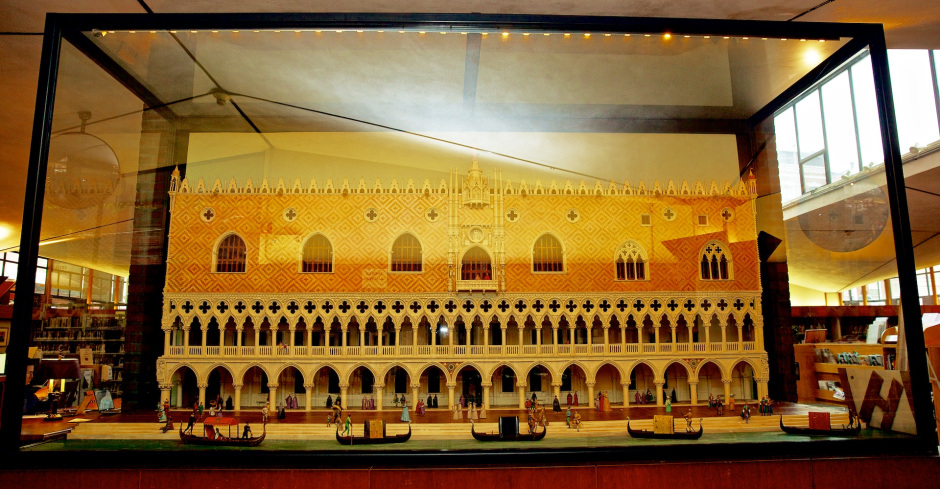The Palazzo Ducale Diorama

What is the Palazzo Ducale?
The Palazzo Ducale, or Doge’s Palace, is a major landmark in Venice, Italy. It is admired
by architects and art historians and is considered to be an outstanding example of
Venetian Gothic architecture. Originally, the Doge’s Palace was the seat of Venetian
government. It was where the Doge, the Chief of State in the Republic of Venice, lived and
where the courts and other administrative offices were located. Today, it is a museum.
The Doge’s Palace inspired the scale model/diorama on permanent display at the North
End Branch Library. The diorama is composed of the sea-facing facade of the Palace
and includes several figurines recreating a lifelike scene from 16th century Venice.
Restoration work, completed in 2013, freshly revealed the model’s fine workmanship
and exceptional detail.
Who built the diorama, and why?
Miss Henrietta Gardner Macy (1854-1927), a teacher and artist, founded a kindergarten
in Boston’s North End in 1878. She spent several years teaching in that school and loved
working with the Italian children from the neighborhood. Miss Macy also had a long
standing desire to see Europe and took advantage of the opportunity to be a European
correspondent for several journals. Eventually, Miss Macy settled in Venice where she
lived for the rest of her life.
While in Venice, Miss Macy wrote many letters to her friends that described her love of
the city and its buildings, especially for the Doge’s Palace. One summer, while hosting
the two young sons of her friends, she built a small model of the Palace to entertain the
children. The boys enjoyed helping her build the diorama. They planned to return to
Venice for another visit during their winter school break. Sadly, the boys contracted
diphtheria (a serious bacterial infection) at school and died shortly thereafter. Miss
Macy was devastated by their deaths and decided to honor the boys’ memory by building
a new, larger model of the Doge’s Palace. She hoped that the model would be
enjoyed by children who were not able to travel to Venice to see the Palace in person.
For three years, Miss Macy worked on the Doge’s Palace model in her spare time. As it
neared completion, art collectors and museums showed an interest in purchasing the
model. Miss Macy accepted an offer from the New York Metropolitan Museum of Art.
When it was finished, Miss Macy made arrangements for the model to be shipped to
New York. It made it as far as England. While being temporarily stored in a warehouse, it
was completely destroyed by fire. Miss Macy began work on another model of the
Doge’s Palace with revised and improved plans. Again, she worked in her spare time and
spent several years working on the second model. Again, many people expressed an
interest, but no one would guarantee purchase until the work had been completed. Miss
Macy died in 1927 in Venice at the age of 73, leaving the model unfinished.
How did the diorama get to Boston
After Miss Macy’s death, her friend Miss Nina C. Mitchell hired craftsmen to finish the
Doge’s Palace model as a memorial to Miss Macy. The completed model was then
presented as a gift to the North End Branch Library for the enjoyment of the
neighborhood, including the descendants of those children who Miss Macy had taught
in her North End kindergarten.
Who do the figurines represent?
The Doge’s Palace contains several figurines that recreate life from 16th century Venice.
These figures were created by Miss Louise Stimson of Concord, Massachusetts. They
include:
● Paolo Veronese, an artist, walking with his wife.
● The Companions of the Hose, a group of musicians, getting ready to play.
● A widow dressed in black, but wearing a gray veil – a sign that she is interested in
finding another husband.
● Two fashionable ladies of the court walking cautiously along the dock, wearing
shoes with wedge soles sixteen to eighteen inches tall.
● Younger men wearing colorful knee breeches; men over twenty wearing long
black gowns.
● Dignitaries of the State wearing red or purple gowns.
● Patricians wearing white gowns – the uniform of the Order of St. John the
Evangelist.
● Other figures in the diorama include Franciscan monks, foreign merchants, a
beggar wearing a black hood to hide his identity, peasants coming from the
market, and a young man carrying a marriage chest.
The Palazzo Ducale Diorama Restoration
In 2013, the Friends of the North End Branch Library commissioned Clifford Craine of Daedalus,
Inc., Watertown, MA, to restore the Ducale Diorama by hand. This restoration was made
possible by a generous donation from Eugene and Corinne Reppucci, through the family
Memorial Trust. It was made in the memory of Eugene’s mother Anna Reppucci, who was born
in the North End and was a lifelong friend of the North End Branch Library.
Would you like to know more?
Learn more about the Doge’s Palace: by clicking here.
Read about Miss Macy’s life: The Nun of the Ca’ Frollo: the Life & Letters of Henrietta
Gardner Macy by Bacheler and White by clicking here.
For restoration pictures, click here.